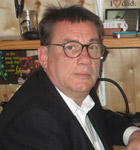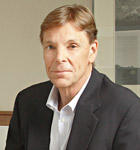Don Kagin recently sold the second-most valuable coin in the world—the 1787 gold Brasher Doubloon, minted by George Washington’s neighbor. It was priced at $7.4 million (just under the $7.6 million for the 1933 $20 dollar gold Double Eagle). Kagin’s eponymous firm, based in Tiburon, California, specializes in rarities from the Gold Rush, early US coins and paper currency ancient money, and an auction division sourcing Western Americana collectibles. Kagin shares with Profile how he’s cashing in on a childhood hobby.
I am often asked, “Why coins?” By far, they are the most important artifact of any civilization. Money will tell you more about a society than any other item. It fuels the economy of the world. Without it, it’s impossible to trade with international neighbors or local merchants.
Take a simple penny, the Lincoln cent. Not only does economics come into play, by way of the value of the currency, but also mathematics, the decimal system, and metallurgy. “Liberty” is emblazoned on it as well as a president’s likeness, both of which make a political statement. (Sometimes we only know who was a leader in a particular era because of a coin.) Social aspects of the time, such as fashion, are evident in the president’s attire.
 Numismatics, the science and study or collecting of coins and currency, is frequently called the king of hobbies and the hobby of kings. Throughout history, collections have been formed by some of the most famous people in our nation’s history, including Thomas Jefferson and Benjamin Franklin. But, the vast majority of collectors today are people from all walks of life, with disposable income, who have an interest in collecting money for the history and art that it represents.
Numismatics, the science and study or collecting of coins and currency, is frequently called the king of hobbies and the hobby of kings. Throughout history, collections have been formed by some of the most famous people in our nation’s history, including Thomas Jefferson and Benjamin Franklin. But, the vast majority of collectors today are people from all walks of life, with disposable income, who have an interest in collecting money for the history and art that it represents.
I was so intrigued by numismatics that I became the first student at Northwestern University to create a degree in the field, as an undergrad. And I am currently the only person to have a doctorate in it, which I earned through the Union Institute and University, also as an independent study track. Because of my expertise, I am often recruited as an expert witness in legal cases regarding fraud in the coin trade.
Coins are an excellent means of education. Through the American Numismatics Association, I helped develop a program called “Coins in the Classroom.” In it, we train teachers of all levels to use coins as didactic tools for their students, in a variety of subjects—from history to economics to anthropology. I also develop coin curriculums for various other trade organizations.
For me, collecting rare coins is more than a hobby; it’s my life’s work. My firm, Kagin’s, was passed down from my father, Art Kagin, who founded it in 1933. What started as a coin shop in Des Moines, Iowa, eventually put him on the map through national auctions. By the end of his life, he had catalogued more than 300 auctions, more than anyone in the history of the industry. Some of my earliest memories reflect my affinity for coins. When I was five years old, I remember my dad bringing home bags of pennies. I would order them by date in various piles—until the housekeeper would dismantle the piles one week, and I would have to start over. But, in spite of that frustration, I liked the challenge of organizing all the coins and eventually registering them in the old “blue books.” I still get a thrill when new interesting coins come in.
In general, a majority of today’s collectors are from the United States, followed by Western Europe. Therefore, some of the most valuable coins originate in the United States or in ancient civilizations. As other countries begin to develop a middle class, they will start to collect more. That has certainly been the case in China, where interest has risen notably in the last few years.
Regardless of national origin, though, collectors are motivated commonly by the challenge of completing a set—either all pieces of a certain denomination, or all values within a series. Once they complete it, they might sell or trade it to form a new collection. That’s what keeps them in the game.
Today, the confluence of a number of economic and market developments have resulted in the beginning of a new rare-coin boom, a remarkable opportunity for investors to diversify their portfolio with tangible assets in the form of bullion and high-performing, investment-quality coins and currency. This is a prudent, profitable and long-term, low-risk alternative investment program, which consists of tangible investments in the form of gold bullion and very rare numismatic gold coins.
Serious investors are looking for alternatives to not just preserve their assets, but for asset appreciation. And many recognize that there is probably no better place to diversify one’s investments than right here. We have helped thousands of investors. We customize each portfolio based on the individual’s goals, and we also provide prudent selling advice—a rarity in the tangible asset investment world. I can confidently claim that in the last decade, virtually every one of my personal clients has made a profit in this endeavor.

